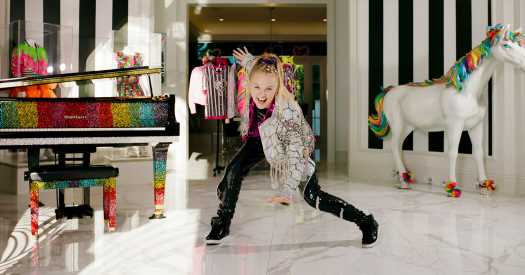
JoJo Siwa Wants to Be ‘a Role Model for People Who Love Love’
09/19/2021A few years ago, JoJo Siwa emerged as a tween wonder on the reality show “Dance Moms,” known for her brassy one-liners, rapid-fire pirouettes and rainbow-hued ensembles topped with huge hair bows.
Today, Siwa, 18, is about to return to dance reality TV — as a budding queer idol. After coming out earlier this year, she will be part of the first same-sex partnership on “Dancing With the Stars.”
Her wardrobe hasn’t changed much.
“When I came out, people were like, ‘How did you not see this coming? She’s always literally been a walking Pride flag!’” Siwa said. “It’s the best compliment.”
In many ways, Siwa remains the same playfully outrageous person fans first encountered on “Dance Moms.” But during the intervening years, she has built an empire on her glitter-and-rainbows star power.
Siwa now has 36.4 million followers on TikTok, 10.9 million on Instagram and 12.3 million on YouTube, where her song “Boomerang” is approaching 1 billion views. She has headlined an arena tour and appeared in TV series and movies, most recently “The J-Team,” a film she also executive produced. She was named one of GLAAD’s 20 Under 20 for 2021, and one of Time’s Most Influential People of 2020. She has sold more than 80 million of her signature hair bows.
From the beginning, legions of preteen girls bought into Siwa’s positive, anti-bullying messaging. Since coming out, she has begun to speak more directly to people her age, who tended to dismiss her as kid stuff. She heads to the 30th season of “Dancing With the Stars,” which premieres on Monday, with all those fans — a.k.a. Siwanatorz — in tow.
“She’s like a living, breathing Mirrorball Trophy,” said Andrew Llinares, an executive producer of “Dancing With the Stars,” referring to its top prize. “She’s colorful in the way she looks, but she’s also colorful in her personality and her aura. She’s just an amazing sort of — being.”
Siwa grew up immersed in dance. Her mother, Jess, owned a dance studio in the Siwas’ hometown, Omaha. Jess had JoJo in competitions when she was just 2, the toddler’s costumes concealing her diaper. “She could turn like nobody’s business, and her presence was unreal,” Jess said. “She would just captivate people.”
Making JoJo a star in the mold of Hannah Montana, the Disney Channel character played by Miley Cyrus, soon became the goal. “I didn’t know that Miley Cyrus and Hannah Montana were two totally different people,” JoJo said. “Hannah Montana was the only human that existed for me, and she was glittery and sparkly and a rock star, and I just wanted to be that human.”
In 2013, the 9-year-old JoJo earned a spot on the “Dance Moms” spinoff “Abby’s Ultimate Dance Competition.” Soon, JoJo and Jess joined the main “Dance Moms” cast. Though not the strongest dancer on the show — she routinely landed at the bottom of its trademark pyramid ranking — JoJo’s outspokenness and unapologetic confidence made her a reality TV natural.
“Dance Moms” offered JoJo a degree of fame, but limited control over her image. In 2015, she started a YouTube channel, which she described as a way to showcase her truest self. “As a 12-year-old, I was editing 10 videos a week, which is wild,” JoJo said. “But it was just my favorite, because I was in charge and I had freedom.”
Millions of followers beyond the “Dance Moms” universe began tuning in to see her share the contents of her taco-print dance bag and make pink slime without using her arms. It was a celebrity rooted in her own eccentricities and enthusiasms, without the shaping of a teen-idol-generating corporation. “In traditional media, there’s kind of a manufacturing of stardom,” said Earnest Pettie, who is the culture and trends insight lead at YouTube. “But by coming to social media, JoJo was able to claim her voice for herself, to tell her own story.”
As her audience ballooned, JoJo became an anti-bullying crusader, encouraging her young fans to be themselves, haters be darned. That positivity, in its shiny, bow-topped packaging, proved highly marketable. And JoJo proved a savvy businesswoman, taking a hands-on approach to her lines of bows and dolls and clothing. (Jess proudly described 13-year-old JoJo holding court in a room full of Walmart executives.)
But despite earning the adoration of 6- to 10-year-olds, she faced increasingly venomous harassment online from fellow teens. “I’ve never really had kid friends my own age,” she said. “But teenagers hated me. I mean, literally hated me.” From her detractors’ perspective, she looked like a phony, forced to perpetually inhabit a lucrative persona created when she was 9.
She wouldn’t have been the only “Dance Moms” cast member to feel trapped in amber. Zackery Lennon Torres, who identified as a boy when she was on “Abby’s Ultimate Dance Competition” and “Dance Moms” as a young teen, came out this spring as a transgender woman. Now 22, she said she “hit pause” on her feelings about gender and sexual identity during her years with the franchise, which had specific ideas about what gender roles Torres would play.
“I didn’t have time to think about where I was in my growth as a person,” Torres said. “After I left the show and went back to high school, I had to figure out that, like, Oh, I wanted a boyfriend. What does it mean to come out? Who am I?”
Siwa, who overlapped a bit with Torres on “Dance Moms,” is quick to express sympathy for her. But Siwa maintains that her “Dance Moms” experience didn’t stifle or alter her, and neither did her ensuing fame.
“Nothing I’ve ever done has been something I didn’t want to do,” she said. “If I wanted to create an alternate identity, I could do that — it’d be easy. I didn’t. This is me.”
Since quarantine, however, there has been a new sense of vulnerability and transparency to Siwa’s online presence. On TikTok her posts became winkingly self-aware. “I started showing people, like, hey, I know you make fun of me, but guess what? I’m game!” she said. “They got to meet a human that maybe they actually like.” After turning 18 in May, she began experimenting with slightly toned-down looks, giving the hair bows a rest.
Siwa came out and introduced her girlfriend, Kylie Prew, in a series of posts in January and February — an undeniably honest moment met, overwhelmingly, with cheers. (She is still figuring out how best to describe her sexuality; for the moment, she said, she’s going with “queer, because it covers it, and it’s cute.”) She has disavowed her homophobic trolls.
“I want to be a role model for people who love love,” she said. “I don’t want to be a role model for people who think being gay is wrong. I don’t need those people in my corner.”
Though Siwa’s ambitions extend to music, acting and production, her “Dancing With the Stars” turn comes at an especially dance-focused moment in her career. Her new film “The J-Team” centers on a dance team, and she is the choreographer in the coming streaming series “Siwa Dance Pop Revolution,” a collaboration with her mother. “Dance has always been home for me,” she said.
“Dancing With the Stars” will help twine Siwa the dancer and Siwa the queer role model together in the public imagination. (There has been some grumbling online about her dance background giving her an unfair advantage on the show, but “Dancing” frequently includes trained dancers in its star lineup.) When the “Dancing” team first approached her earlier this year, they asked whether she’d like to perform with a male or a female pro. “I immediately chose female,” she said. “How awesome is it that I get to be the first, that I get to make history and inspire people this way? That is huge.”
It is huge. And, in some encouraging ways, it isn’t. “Dancing” follows in the footsteps of its BBC cousin, “Strictly Come Dancing,” which featured its first same-sex partnership last year, and the Danish “Dancing With the Stars,” which has already awarded its Mirrorball Trophy to a male-male duo. Since 2019, the National Dance Council of America, the official governing council of traditional ballroom dance in the United States, has defined a couple in ballroom as “a leader and follower without regard to the sex or gender of the dancer.”
Siwa, once seen as stuck in time, is now helping network TV catch up with the times. And her Siwanatorz? They’re already caught up.
“I think the best part,” Torres said, “will be for these young kids to see her dancing with a girl on TV, and not even bat an eye.”
Source: Read Full Article

